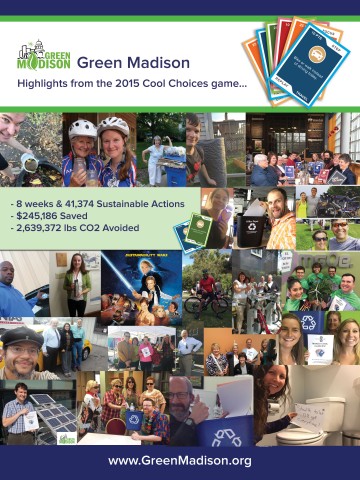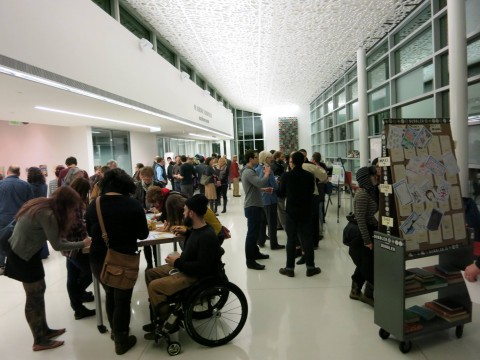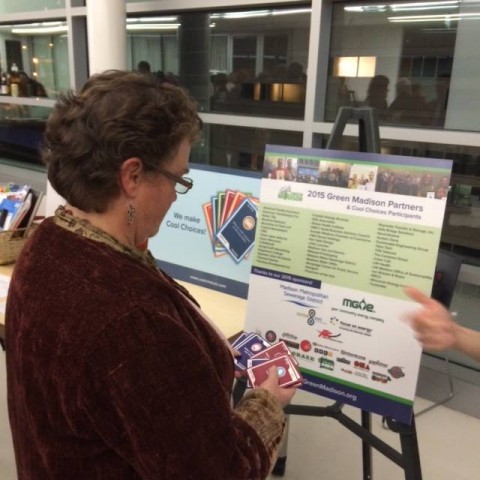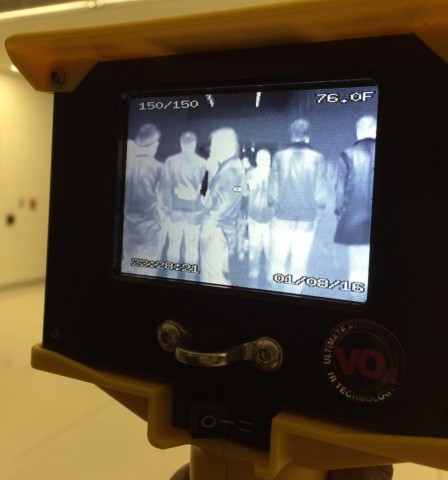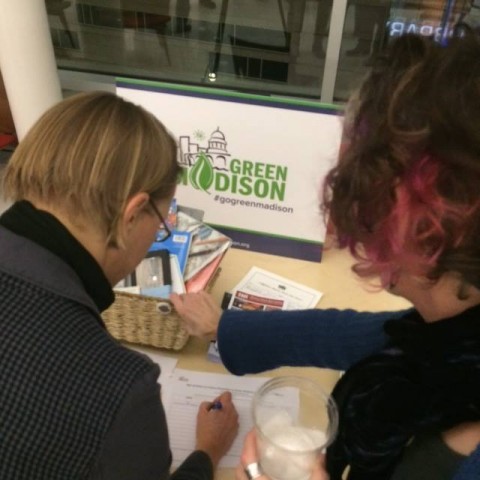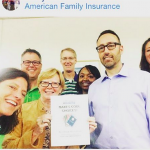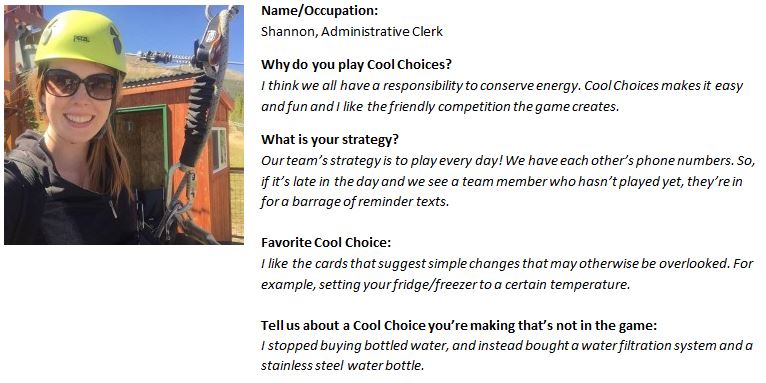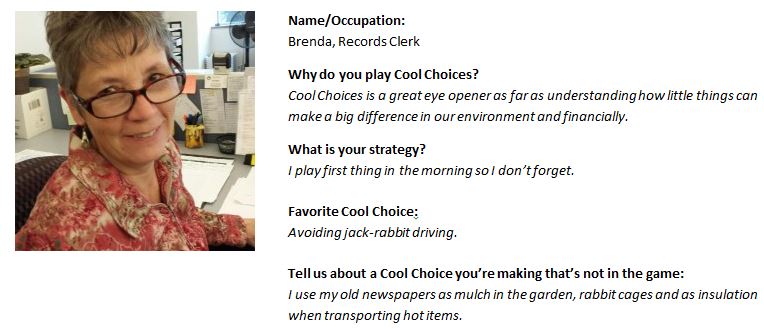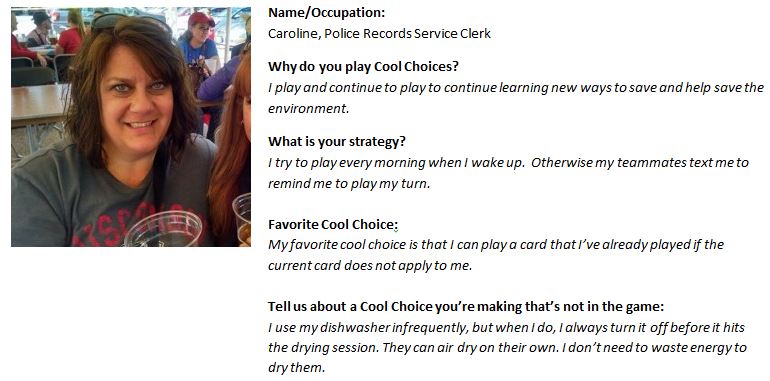Uncategorized
Beyond the Game: Sarah’s Sustainability Story
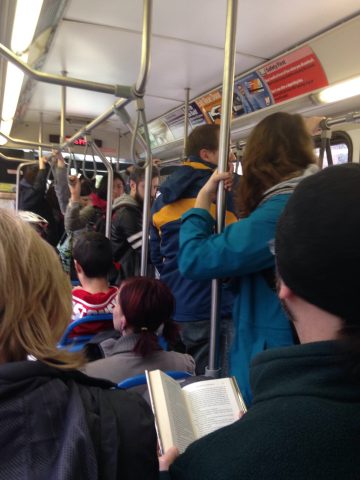
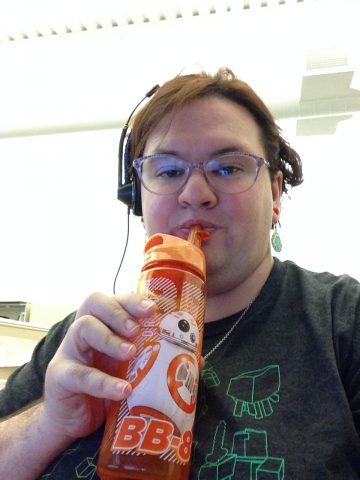 Cool Choices alumni continue to take sustainable actions that inspire their work, home, and community. We were impressed by the cool things Sarah has been up to since taking part in our online sustainability program.
Cool Choices alumni continue to take sustainable actions that inspire their work, home, and community. We were impressed by the cool things Sarah has been up to since taking part in our online sustainability program.
What green activities have you been up to since taking part in the Cool Choices program?
Since the game, I’ve continued commuting to work by bus every day, using compact fluorescent light bulbs (looking into LEDs), and using a reusable water bottle. It’s got BB-8 on it, and I’m thrilled — if you’re going to be using one every day why not make it fun? I’m also planning on starting an herb garden in my apartment, something I can use on a regular basis and something my cat will also enjoy (I’m hoping to find some peppermint plants at the farmer’s market).
What tips do you have for others trying to be sustainable?
My tip is to start small; don’t try to make a ton of changes at once or you’ll drive yourself crazy. Pick one thing, get adjusted to it, and then make another change.
Sarah took part in the 2015 city wide Cool Choices game in Madison, WI.
Want to Green Your Workplace? Ask Your Employees!
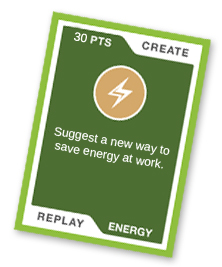 Looking for new and innovative ways to green your workplace? The Cool Choices online sustainability game can help; our game and engagement platform collects great ideas from employees on greening the workplace and builds a buzz about sustainability at your organization.
Looking for new and innovative ways to green your workplace? The Cool Choices online sustainability game can help; our game and engagement platform collects great ideas from employees on greening the workplace and builds a buzz about sustainability at your organization.
For example, a 30-point card prompts, “Suggest a new way to save energy at work.”
This is a simple and effective way to get employee engagement—and input specific to your organization—around sustainable changes that can be implemented. In just a few minutes a day, Cool Choices makes sustainability and energy-saving measures top of mind for your employees and delivers concrete energy and cost-saving strategies. Our clients receive an End-of-Game Report (including a compilation of employee suggestions) as part of their Cool Choices implementation.
Curious about the kinds of suggestions Cool Choices participants make?
Our clients see three kinds of ideas, each providing a different engagement opportunity:
 1. Hidden Opportunities for Savings
1. Hidden Opportunities for Savings
In many cases participants identify very specific savings opportunities that were not visible to sustainability leaders. In our work with a regional healthcare network, for example, a small rural clinic had developed an innovative recycling strategy; when a participant shared the idea via Cool Choices the organization’s leadership was able to replicate it in other locations. In many cases front line staff have the clearest view on where resources are being wasted; soliciting their ideas can accelerate efficiencies.
 2. Support for New Organization-level Protocols
2. Support for New Organization-level Protocols
Participants often suggest practical organization-wide changes that will reduce overall resource use. In many games participants identify a number of strategies for reducing fleet costs—like new protocols for carpooling and vehicle selection. Often these ideas are not new; typically both sustainability and accounting staff had identified most of the savings opportunities previously. Leaders didn’t pursue the ideas, though, due to concerns about staff acceptance. By providing bottom-up momentum—ideas about how the organization can live its commitment to sustainability, coming from everyone across the organization versus just another cost saving idea from the folks in accounting—the Cool Choices program provided an opportunity to talk about and implement these ideas.
 3. Audacious Goals
3. Audacious Goals
Some participants will suggest dramatic changes that are seem well beyond an organization’s current goals—like installing sufficient solar panels to power an entire factory. Within the game these suggestions provide a unique two-way opportunity for dialogue and education. Helping staff understand, for example, the number of panels required to power an industrial operation can increase staff appreciation for the value of energy efficiency. At the same time, leaders gain insights from the kinds of audacious goals participants suggest—knowing that staff support audacious goals can nudge leaders to think bigger as they update organization-wide sustainability goals.
If you’d like to engage your employees in innovative approaches to accelerate your organization’s sustainability efforts, please contact us.
Celebrating a City-Wide Sustainability Initiative
Last Friday Cool Choices joined the rest of the Green Madison team and hundreds of guests at Madison’s Central Library. During this after-hours Night Light event we celebrated and connected with players who took part in the fall 2015 city-wide Cool Choices online sustainability game. The energy, water and financial savings these participants achieved was phenomenal and we’re looking forward to an even larger municipal game of Cool Choices in Madison this spring.
Check out the 40+ Madison businesses and organizations that took part in the fall 2015 Cool Choices online sustainability game.
Thanks to everyone who came out in support of Cool Choices and making Madison more sustainable! We hope you enjoyed browsing the art exhibits, experimenting with “infrared drawing,” and celebrating your participation in the game-based approach to building sustainable habits and reducing energy use city-wide.
Photo highlights from the celebration below!
Want to Green Your City? Try a Game-Based Approach!
Interested in mobilizing an entire city around sustainability? A game can help.
In 2015 the City of Madison (WI) asked Cool Choices to implement online community-wide games to inspire behavior change, reduce energy use and mobilize the city around sustainability initiatives. This is part of the City’s effort to win the $5 million Georgetown University Energy Prize. During the summer Cool Choices implemented a game with City employees and in September we launched our first community-wide game as part of Green Madison.
To date, Cool Choices has been implemented primarily in workplaces—we help our partners, whether private firms or public agencies, engage employees around sustainable practices. Our online employee engagement game makes it fun, social and easy for individuals to save money, reduce waste and become part of the solution.
Some have asked whether the Cool Choices game could work in other kinds of communities like churches or neighborhoods or even across multiple workplaces. Naturally we’ve had theories, but now we’ve got evidence.
A Municipal Sustainability Initiative & Real Results
The City of Madison community-wide game of Cool Choices involves almost 900 people on teams from more than 40 different businesses, neighborhood associations and community groups. These participants have reported more than 41,000 “cool choices” (sustainable actions), representing over $240,000 in annual savings.
More, Madison’s community-wide game is creating conversations about sustainability in multiple venues across the city. Participants who rent earned points for having conversations with their landlords about efficiency upgrades; homeowners are sharing their conservation strategies in the game’s social stream and, as always, players are posting photos that show off their new sustainable practices.
Implementing a game at the municipal level involves more challenges than a single-business game, to be sure, but there are also more rewards. By celebrating the sustainable actions various Madison participants are taking we’re shifting the conversation and building momentum at a community-wide level. After playing Cool Choices participants are empowered—they know their actions matter and they see themselves as part of a community that shares a commitment to reduce waste and preserve natural resources.
We’ll continue to implement additional rounds of the Cool Choices game in Madison in 2016. We are excited to see even more of what this impressive community will accomplish.
Curious about how Cool Choices can help your city or organization save money and get sustainable? Contact us and we’ll get back to you with more information.
Player Profiles from Green Madison
In Madison, Wisconsin, Green Madison has launched a city-wide round of Cool Choices as part of the city’s effort to win the Georgetown University Energy Prize. We’re pleased to introduce you to the members of one of the top teams from this game, the MPD Civilians.
Read on to learn the secrets of their sustainability success & why they play Cool Choices.
The “MPD Civilians”
Cool Choices Green Madison Overall Game Update:
Curious about how Cool Choices can help your organization save money and get sustainable? Contact us and we’ll get back to you with more information.
It Is Not About Sacrifice, It’s About Living More
As a veteran of almost two decades of energy efficiency efforts, I’ve had hundreds of people start conversations with me by saying “You know, I tried [insert efficiency product or practice here] and…”
Over time I learned to brace myself, to force a fixed smile as I listened—because as often as not, what followed the “and” was negative.
“And I didn’t see any savings.”
“And my wife hated the way the light looked.”
“And it didn’t work as well as our old model.”
“And the contractor left a huge mess.”
Now I’m watching Cool Choices’ first corporate partnership unfold and once again I’m listening to stories. Participants in the pilot are encouraged to share stories, photos or videos about what they are doing and how it’s going.
Some participants tell us that because they are watching less TV, they are spending more time outside, spending more time interacting with other family members, going for walks, and reading more.
Others tell us that avoiding jackrabbit starts and stops while driving was a challenge at first but now they find driving more relaxing. They arrive at their destination on time and feeling better about the other people on the road.
Multiple participants tell us about how they’ve involved their children, saying that Cool Choices has prompted broader and deeper conversations about sustainability.
The stories make clear that lots of participants are very proud (and justifiably so) about how they are taking control of their energy usage.
Up front we talked to these people about the financial benefits they could see via the game but now it’s clear that they are seeing benefits beyond the financial. Participants are experiencing:
- Mental health benefits associated with more social interactions, less road rage and feelings of greater control of their own lives.
- Physical health benefits associated with more opportunities for exercise, more time outside and less stress This is, I think, the magic pixie dust that’s needed to make change happen.
When people feel (yes, feel—in their guts) that being more sustainable actually improves the quality of their life, then we’re on the right track. Suddenly the benefits outweigh the hassles and sustainability isn’t about doing less—it’s about living more.
I can’t wait to read next week’s stories.
Believing in People
Do we believe we have the will to do what’s necessary to slow global warming?
The latest Yale University survey suggests that Americans are increasingly doubtful about our collective will. The percentage of Americans who assert that it’s possible to slow warming “but people aren’t willing to change their behavior so we aren’t going to” has risen four percentage points while those who believe “it’s unclear at this point whether we will do what’s needed” dropped six points. Other categories—including those who deny there’s any warming and who are sure humans will fix everything—stayed relatively constant.
I read those results as a drop in confidence in each other.
The lack of confidence is striking because Cool Choices is in the midst of a pilot at Miron Construction that gives me great cause for optimism. At Miron, more than half of the company’s employees are regularly taking actions to reduce their emissions, having fun and becoming part of the solution.
As I watch what’s happening at Miron a couple of things are clear to me.
First, people want to do the right things—to save money (which enables them to have funds for other priorities), to preserve local resources (so that their kids and grandkids have access to those same resources), and to lead by example.
Second, knowing you are doing the right things feels good. The employees at Miron are sharing their successes with us and their colleagues because they are proud, because these are successes.
And, finally, doing the right things can be contagious. One successful change can lead to another and your successes can prompt a co-worker to make a change as well. The process is slow and far from linear, but ultimately the hundreds of small successes (and people who are glowing with pride at what they’ve accomplished) are how we can build whole communities that are part of the solution.
The climate challenges ahead of us are enormous, but I’m not ready to give up on humans just yet.
To Be Social It Has to Be Fun
Jayme Heimbuch at Treehugger.com published a piece a few weeks ago about the failure of energy conservation to engage people via social networking, suggesting that perhaps people were the problem (because we seem to care more about celebrities than kilowatt hours).
Three weeks into a pilot where people are sending us photos, bragging to us and their colleagues about the electric savings they’ve uncovered, I’ve a different take on all of this.
Most existing energy conservation efforts haven’t engaged people in social media around their sites because the efforts are not any fun. Most of the tools function more like a test than a game, requiring you to gather and interpret all kinds of data before you can do anything the least bit fun. It would be akin to Trivial Pursuit requiring players to complete a comprehensive assessment to optimize team assignments. Imagine how much fun that would be.
Actually it would be about as much fun as filling out screen after screen of questions about your electric usage and insulation levels—stuff regular people don’t think about.
Disclosure: I’m an absolute energy geek. At my house the utility bill is something we open and discuss, as soon as it arrives. And then we input the data into customized spreadsheets, marvel at the graphs and talk about it some more.
But most people are not like me. Whereas I enjoy filling out carbon calculators and comparing the results from one tool to another, most regular people (our target market) find this a burden. And most people have enough burdens already.
Game developers have taught me that if you want to engage people you need to provide opportunities for early successes, to let players feel good about their efforts. It has to be fun.
Asking people questions they can’t answer about their appliances or energy usage makes them feel bad, incompetent even. It is not fun. While a few might dig in to learn more, most will drop out, opting to spend their time on something more pleasant. And we wonder why these folks aren’t posting their results on Facebook? What should they post?
Just learned I don’t know how to read my utility bill – even though I’ve been paying it for years. It’s probably also time to admit that I can’t reset the clock on the microwave.
Our initiative, by contrast, empowers people. Participants can take easy actions, without having to learn how kWh converts to tons of CO2. We give participants clear signals—points—to value their actions. In our experience people immediately grasp this approach, seeking out high point-value actions that fit into their lives.
We’re finding that a few people want to get into the details. We support and celebrate those efforts but that’s not the main event. The main event is regular people taking action and bragging to their colleagues about the points they’ve accumulated.
By making this fun and easy we have engaged participants who intend to continue taking actions that, in aggregate, will generate meaningful savings and reduce greenhouse gas emissions over the long run.
And isn’t that the real objective?

